|
 1913, France: Morane-Saulnier L
1913, France: Morane-Saulnier L

|
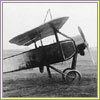

|
|
The brothers Leon and Robert Morane designed this monoplane
with fellow engineer Raymond Saulnier in 1913. The fragile L
was meant for reconnaissance, but by the war's start Saulnier
had attached steel plates to the plane's propeller, allowing
the pilot to fire rounds from a fixed 8-millimeter Hotchkiss
machine gun without bombarding the propeller. (The plates
deflected bullets away from the propeller blades.) French ace
Roland Garros tested the Morane-Saulnier L in April of 1915
and scored three victories in as many weeks. By month's end,
the Germans had managed to capture the airplane (note the
German insignia painted on the tail) and they began work on a
copy.
|
|
 1915, Germany: Fokker Eindecker
1915, Germany: Fokker Eindecker

|
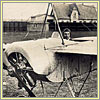

|
|
This plane was a nearly exact copy of the Morane-Saulnier L,
except that it featured aircraft designer Anthony Fokker's
signature tail design and a synchronized machine gun firing
mechanism, the first of its kind. Fokker fitted his Eindeckers
with a forward-facing 8-millimeter gun, which could fire its
bullets between the moving propeller blades without causing
bullets to ricochet off them. Though the Eindeckers were
underpowered and slow, their firing mechanism marked a major
step forward in aerial combat and gave the Germans total air
superiority during the 1915 "Fokker Scourge."
|
|
 1915, Britain: De Havilland D.H.2
1915, Britain: De Havilland D.H.2

|
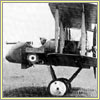

|
|
As an answer to the Fokker Eindecker, Geoffrey de Havilland
designed the D.H.2 biplane, his second aircraft for the
British Aircraft Manufacturing Company. The plane was a
so-called "pusher"—its rear-mounted engine and propeller
pushed the aircraft forward from the rear rather than pulling
it from the front. This design enabled the D.H.2 to carry a
fixed, forward-facing machine gun that did not interfere with
the propeller. With its excellent climbing speed and high
level of maneuverability, the D.H.2 helped end the "Fokker
Scourge" by early 1916.
|
|
 1916, France: Nieuport 17
1916, France: Nieuport 17

|
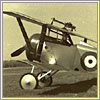

|
|
Gustave Delage's Nieuport 17 biplane made its debut in March
1916 and was a favorite of many Allied aces, including
Englishman Philip Fullard, who scored 40 victories piloting
his Nieuport 17. The plane was highly maneuverable and easily
outperformed the Fokker Eindecker; within a few weeks of its
debut, German high command ordered its engineers to copy the
plane. Delage fitted the Nieuport 17 with a synchronized
Vickers machine gun, the first Allied plane to feature this
technology. The Nieuport was not without flaws, however, the
most worrisome being a tendency to lose its lower wings in
steep dives.
|
|
 1916, France: SPAD VII
1916, France: SPAD VII

|
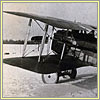

|
|
This French Air Service fighter, armed with a synchronized
Vickers .303 machine gun, made its first combat flight in July
1916 and immediately showed great promise. Like the Nieuport
17 that it replaced, the plane was agile in the air, yet it
was more rugged and could make steep, swift dives without
disintegrating. Pilots of the Lafayette Escadrille, a group of
American pilots who joined the Allied air effort in France,
flew SPAD VII single-seaters almost exclusively from the time
they officially joined the war effort in 1916.
|
|
 1916, Britain: Sopwith Triplane
1916, Britain: Sopwith Triplane

|
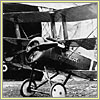

|
|
The Sopwith Triplane's stack of three wings combined ample
wing area with a narrow width (or "chord"), giving it
significantly more climbing power and maneuverability than its
biplane counterparts. The Sopwith's pilots also enjoyed
excellent visibility from its cockpit, the lack of which was a
problem in many popular biplanes, including the SPAD VII. The
triple-decker construction of this Sopwith profoundly
influenced aircraft designs in other countries, particularly
Germany. Within months of the Triplane's first flights nearly
every German airplane manufacturer was hard at work designing
a triplane of its own.
|
|
 1917, Germany: Albatros D. III
1917, Germany: Albatros D. III

|


|
|
German manufacturer Albatros Works unveiled the Albatros D.
III biplane in January 1917. The plane featured V-struts
between its wings, which allowed for a shorter lower wing.
Pilots of the Albatros could see their targets and the terrain
below much more readily with this design, which gave them an
edge in dogfights. Manfred von Richthofen, later dubbed the
"Red Baron," was among the first to fly the Albatros, and he
experienced firsthand its weakness: the V-struts could cause
the lower wings to twist and crack apart in flight.
|
|
 1917, Germany: Fokker Dr. I
1917, Germany: Fokker Dr. I

|
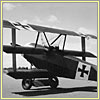

|
|
This triplane was the signature plane of Baron von Richthofen,
whose red-painted model inspired his moniker, the "Red Baron."
Modeled after the Sopwith Triplane, the German plane boasted
all of the earlier plane's advantages. It was small,
lightweight, and nimble, yet it could easily outclimb its
opponents. A Dr. I pilot had excellent visibility from the
cockpit, where he used special firing buttons to operate two
synchronized 8-milimeter Spandau machine guns. These
characteristics, along with the fact that Fokker had designed
the plane without relying on the standard wing-bracing wires
that were easily shot apart during combat, made it a superb
dogfighter.
|
|
 1917, Britain: Sopwith Camel
1917, Britain: Sopwith Camel

|


|
|
This famous biplane accounted for more aerial victories than
any other Allied aircraft during the war, destroying over
1,200 enemy fighters. The plane acquired the name "Camel" from
its twin Vickers .303 machine guns, which were housed in a
camel-like "hump" at the front of the plane. Proud pilots
liked to add that the aircraft also behaved like a camel: it
seemed docile but was quick to bite when agitated. The plane's
success was largely due to its extreme maneuverability, but
these characteristics also killed many an inexperienced pilot
in vicious spins.
|
|
 1918, Germany: Fokker D. VII
1918, Germany: Fokker D. VII

|
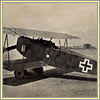

|
|
Having honed their aviation engineering skills by the final
year of the war, the Germans released their best aircraft,
Fokker's D. VII, less than a year before armistice. The Red
Baron had championed the plane's design during its development
phase, and in January 1918 he tested the plane in trials,
though he was killed just days before it officially entered
combat, in April of that year. Equipped with a state-of-the
art BMW engine and a thick airfoil, the biplane behaved nimbly
at all speeds—even at an almost standstill—and was
credited with making expert pilots out of mediocre ones simply
by virtue of its ease in the air.
|
|

|

